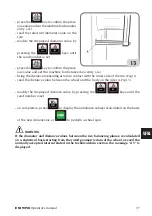
106
EM 9250
Operator’s manual
3 Apply the adhesive weight manually in the position in which the relative plane was
measured, using the centre of gravity of the weight itself as reference. In this phase, one
display shows the unbalance value of the side to be balanced and the other shows the
message "H.6" that indicates the correct position of application as shown in figure 19.
• Adhesive weights applied manually without the weight-holder device (CLIP adhesive
weight application position enabled)
1 Select the first side to be balanced.
2 Turn the wheel until the central element of the corresponding position indicator lights
up. Keeping the wheel in position with the clamping brake, a display will now show the
quantity of the weight to be applied in gr/ounces and the other will display the distance
in mm alternatively to the plane identification abbreviation (A-1 for Inner Plane/A-2 for
Outer Plane).
3
IN THE MACHINE VERSION WITH AUTOMATIC SENSOR
move the sensor until it
reaches the indicated position. During this phase, the unbalance value of the side to be
balanced is shown on one display, whereas the numerical value updated according to
the sensor position, which becomes zero when the position for application of the weight
is reached, is shown on the other display.
IN THE MACHINE VERSION WITH MANUAL SENSOR
with the wheel in a centred
position, the machine indicates the unbalance value on a display, whereas the other
display shows the message "d1" or "d2" alternately to the distance value of the plane
corresponding to the body.
Move the sensor to the position shown on the display in which the message "d1" or "d2"
appears alternately to the distance value (the distance is read on the rule)
4 Apply the adhesive weight manually, using the centre of the notch in the holder as the
reference for the centre line of the weight.
“Shift planes” programme (only with ALU P programmes)
This function is automatically enabled when an ALU P programme is selected.
It modifies the former selected positions for the application of adhesive balancing weights,
in order to allow perfect wheel balancing using commercially available adhesive weights
in multiples of five grams.
The accuracy of the machine is thereby improved, avoiding rounding-off or cutting the weights
to be applied to come closer to the actual unbalance values.
10. PROGRAMME FOR POSITIONING THE WEIGHTS
BEHIND THE SPOKES “HIDDEN WEIGHT”
(ONLY WITH ALU 1P AND ALU 2P PROGRAMMES)
For alloy wheels, use the Hidden Weight programme in conjunction with the ALU 1P or ALU
2P programme to conceal the external weight behind two spokes for aesthetic reasons.
The Hidden Weight programme can only be activated if there is an unbalance on the outer side.
This programme divides the outer weight Pe into two weights P1 and P2 located in any posi-
tion chosen by the operator. The only condition is that the two weights and the original outer































